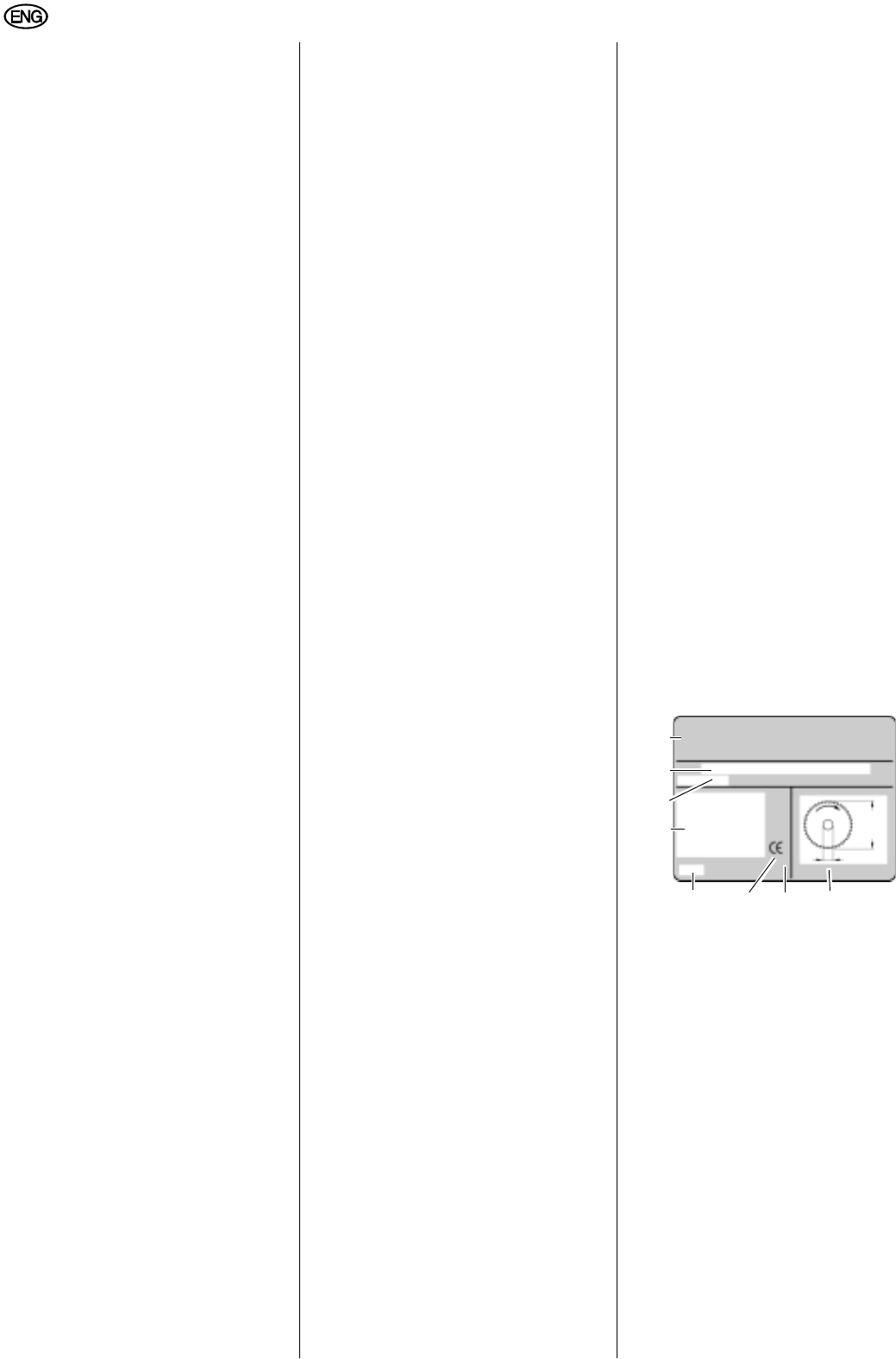
16
ENGLISH
B
Danger! Risk of electric shock!
x Do not expose tool to rain.
Do not operate tool in damp or wet
environment.
Prevent body contact with earthed
objects such as radiators, pipes,
cooking stoves, refrigerators when
operating this tool.
x Do not use the power cable for pur-
poses it is not intended for.
A
Risk of personal injury and
crushing by moving parts!
x Do not operate the tool without
installed guards.
x Always keep sufficient distance to
the saw blade. Use suitable feeding
aids, if necessary. Keep sufficient
distance to driven components
when operating the electric tool.
x Wait for the saw blade to come to a
complete stop before removing cut-
offs, scrap, etc. from the work area.
x Do not attempt to stop the saw
blade by pushing the workpiece
against its side.
x Ensure the tool is disconnected from
power before servicing.
x Ensure that when switching on (e.g.
after servicing) no tools or loose
parts are left on or in the tool.
x Turn power off if the tool is not used.
A
Cutting hazard, even with the
cutting tool at standstill!
x Wear gloves when changing cutting
tools.
x Store saw blade in such manner that
nobody will get hurt.
A
Risk of kickback (workpiece is
caught by the saw blade and thrown
against the operator):
x Always work with a properly set riv-
ing knife.
x Do not jam workpieces.
x Make sure the saw blade is suitable
for the workpiece material.
x Cut thin or thin-walled workpieces
only with fine-toothed saw blades.
x Always use sharp saw blades.
x If in doubt, check workpiece for
inclusion of foreign matter (e.g. nails
or screws).
x Cut only stock of dimensions that
allow for safe and secure holding
while cutting.
x Never cut several workpieces at the
same time – and also no bundles
containing several individual pieces.
Risk of personal injury if individual
pieces are caught by the saw blade
uncontrolled.
x Remove small cutoffs, scrap, etc.
from the work area – when doing so
the saw blade must be at a com-
plete standstill.
c
Drawing-in/trapping hazard!
x Ensure that no parts of the body or
clothing can be caught and drawn in
by rotating components (no neck-
ties, no gloves, no loose-fitting
clothes; contain long hair with hair-
net).
x Never attempt to cut any workpieces
which contain
ropes,
strings,
cords,
cables or
wires, or to which any of the
above are attached.
A
Hazard generated by insuffi-
cient personal protection gear!
x Wear hearing protection.
x Wear safety glasses.
x Wear dust mask.
x Wear suitable work clothes.
x When working outdoors wearing of
non-slip shoes is recommended.
A
Risk of injury by inhaled wood
dust!
x Dust of certain timber species (e.g.
beech, oak, ash) can cause cancer
when inhaled. Work only with a suit-
able dust collector attached to the
saw. The dust collector must comply
with the data stated in the technical
specifications.
x Ensure that as little as possible
wood dust will get into the environ-
ment:
remove wood dust deposit in the
work area (do not blow away!);
fix any leakages on the dust col-
lector;
ensure good ventilation.
A
Hazard generated by modifica-
tion of the machine or use of parts
not tested and approved by the equip-
ment manufacturer!
x Assemble tool in strict accordance
with these instructions.
x Use only parts approved by the
equipment manufacturer. This
applies especially for:
saw blades (see “Technical
Specifications” for stock nos.);
safety devices (see “Technical
Specifications” for stock nos.).
x Do not change any parts.
A
Hazard generated by tool
defects!
x Keep tool and accessories in good
repair. Observe the maintenance
instructions.
x Before every use check tool for pos-
sible damage: before operating the
tool all safety devices, protective
guards or slightly damaged parts
need to be checked for proper func-
tion as specified. Check to see that
all moving parts work properly and
do not jam. All parts must be cor-
rectly installed and meet all condi-
tions necessary for the proper oper-
ation of the tool.
x Damaged protection devices or
parts must be repaired or replaced
by a qualified specialist. Have dam-
aged switches replaced by a service
centre. Do not operate tool if the
switch cannot be turned ON or OFF.
x Keep handles free of oil and grease.
A
Risk of injury by noise!
x Wear hearing protection.
x Make sure the riving knife is not
bend. A bent riving knife will push
the workpiece against the side of the
saw blade, causing noise.
3.3 Symbols on the machine
Information on the nameplate:
(22) Manufacturer
(23) Serial number
(24) Machine designation
(25) Motor specifications (see also
"Technical specifications")
(26) Year of make
(27) CE-mark – This machine con-
forms to the EC directives as per
Declaration of Conformity
(28) Waste disposal symbol – the
machine can be disposed of
through the manufacturer
(29) Dimensions of permissible saw
blades
23
24
25
26 27
29
22
28


















